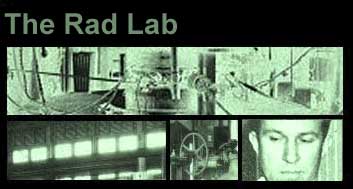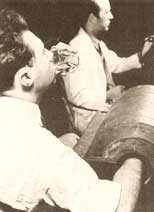

The more energetic the particles produced by an accelerator, the more interesting physics they can create in the laboratory. Lawrence did not remain satisfied with the million-volt protons provided by his eleven-inch cyclotron, but hoped to increase the energy by a factor of ten or more. Higher energies required bigger magnets and faster oscillators. It also demanded more money. It was not a good time to raise money for research, as the U.S. reached the depths of the Great Depression. Universities in general suffered less than other segments of society. Still, in 1933 the physics department of the University of California at Berkeley had to cut its research budget by a third and impose an austerity program of lower salaries and fewer teaching assistants. |
|

|
|
|
|||||||
|
|
The university provided the remainder of the funds and a building to house the new machine. In August 1931 an old civil engineering building was made available for Lawrence, which came to be called the Radiation Laboratory. The building housed a new 27-inch cyclotron, with an 80-ton magnet originally built to power a transatlantic radio link in World War I. Lawrence acquired the magnet at a discount as war surplus. By September 1932 the cyclotron was accelerating protons up to 3.6 million electron-volts. |
|
|
In what became typical for Lawrence, he was already planning his next machine before the current one started working. In 1937 he had a 37-inch cyclotron operating, followed two years later by a 60-inch device. To build the succession of machines Lawrence solicited $550,000 worth of expenses and equipment for his laboratory between 1931 and 1940. Donors included the state of California through the university; private philanthropies, notably the Macy and Rockefeller Foundations; and the federal government through the National Cancer Institute. Industrial firms donated equipment. "The trade of a ‘cyclotroneer' is one which has experienced no depression."—A student of Lawrence in 1938 |
||||||||||
 Rad Lab staff demonstrated the potential application of radioactive isotope tracers in public lectures. A volunteer would drink a "radiosodium cocktail" of salt water containing radiosodium, and trace its progress through the body with Geiger counters. |
The federal government also provided support through two New Deal agencies, the Works Progress Administration and the National Youth Authority, which put electricians, machinists, carpenters, and other technical assistants to work in the Rad Lab on the government's payroll. The Depression also produced a steady supply of physicists willing to work for nothing in order to learn cyclotronics. From 1933 to 1940 the Rad Lab had several graduate and postdoctoral students paying their own way at the lab. They helped the Rad Lab staff grow from a total of ten in 1932 to sixty in 1939.
|
|
Posing with the newly completed 60-inch cyclotron in the Crocker Laboratory are (left to right) Donald Cooksey and Ernest Lawrence. |